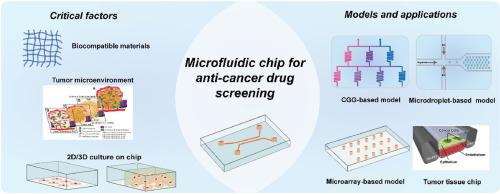Trends in Analytical Chemistry ( IF 11.8 ) Pub Date : 2020-11-12 , DOI: 10.1016/j.trac.2020.116118 Yiwei Shi , Ying Cai , Yuhong Cao , Zhanying Hong , Yifeng Chai

|
To accelerate the discovery of anti-cancer drugs, there is an urgent need to establish an inexpensive and simple preclinical model that can simulate the tumor microenvironment and screen the drug candidates. Some widely used screening platforms are high-cost and over-simple to verify the cell-drug interactions for predicting human clinical trial outcomes. As a promising technology, microfluidic chip can replace traditional screening methods due to low reagent consumption and the capability of recapitulating the 3D cell culture more representative of the native tumor microenvironment. This review covers the materials for microchip fabrication (especially hydrogel), tumor microenvironment, 2D and 3D tumor culture on chips, drug screening methods (concentration gradient generator-based, microdroplet-based, microarray-based chips, and tumor tissue chip), and their pros and cons for cancer treatment. We also discuss the future development of microfluidic for anti-cancer drug discovery research.
中文翻译:

微流体技术的最新进展及其在抗癌药物筛选中的应用
为了加速抗癌药物的发现,迫切需要建立一种廉价且简单的临床前模型,该模型可以模拟肿瘤微环境并筛选候选药物。一些广泛使用的筛查平台价格昂贵且过于简单,无法验证细胞药物相互作用以预测人类临床试验结果。作为一种很有前途的技术,由于低试剂消耗和能够再现3D细胞培养物的能力(更能代表天然肿瘤微环境),微流控芯片可以代替传统的筛选方法。这篇综述涵盖了用于微芯片制造(尤其是水凝胶),肿瘤微环境,芯片上2D和3D肿瘤培养的材料,药物筛选方法(基于浓度梯度发生器,基于微滴,基于微阵列的芯片,和肿瘤组织芯片)及其在癌症治疗中的利弊。我们还将讨论用于抗癌药物发现研究的微流体的未来发展。









































 京公网安备 11010802027423号
京公网安备 11010802027423号